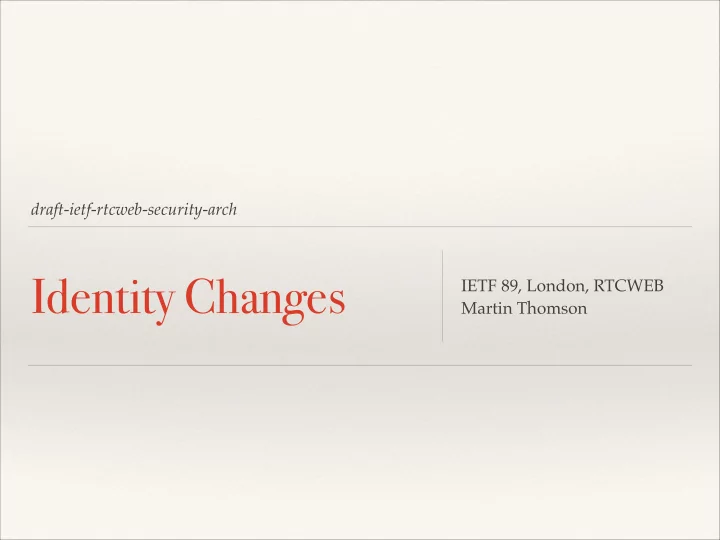

draft-ietf-rtcweb-security-arch Identity Changes IETF 89, London, RTCWEB � Martin Thomson
Issue 1: Username ❖ API has three options to setIdentityProvider: � ❖ IdP name, IdP protocol, and user name (hint) � ❖ Proposal: add username to the message, like so: � { "type": "SIGN", "id": "12", "origin": "https://example.org", "message": "...the binary blob...", "username": "user@example.com" } https://github.com/ekr/ietf-drafts/pull/16
Issue 2: User Login ❖ Draft currently requires the IdP to interact with the user to log them in if they can’t authorise the “SIGN” message � ❖ This doesn’t work very well in practice � ❖ Breaks the sandbox � ❖ Makes the process more brittle � ❖ Proposal: LOGINNEEDED message with a URL that the application can load to allow the user to log in { "type": "LOGINNEEDED", "id": “12", "error": "Signature verification failed" "loginUrl": “https://login.example.com/?somecontextmaybe" } https://github.com/ekr/ietf-drafts/pull/13
Issue 3: Multiple Fingerprints v=3 � o=no � s= � c=IN IP4 example.com � t=2 3 � a=identity:identityassertiongoeshere � … � m=audio 9 blah… � SDP! a=fingerprint:md5 8ad287bf9a4b0c3a256d1f4f7cd0a8df � … � m=video 0 blah… � a=fingerprint:md5 8e532b772cb0e033d59c81801a2efa3e � … { � “fingerprint”: { � Assertion: “algorithm”: “md5”, “digest”: “ 8…oops ” � } � }
Issue 3: Multiple Fingerprints ❖ Option 1: Do nothing � ❖ Not important for browsers; keep things simple � ❖ Option 2: Multiple identity assertions, same identity � ❖ Create a different identity assertion for each fingerprint � ❖ Option 3: Include multiple fingerprints � ❖ Have the assertion cover all of the fingerprints in use � ❖ Maybe make a=identity an exclusively session-level attribute https://github.com/ekr/ietf-drafts/pull/13
4: Fingerprint Algorithm Mismatch ❖ In theory—it’s not specified—it is possible for the hash algorithm in a=fingerprint and the identity assertion to be different � ❖ Validating this blocks setRemoteDescription() , maybe � ❖ Proposal: the algorithm in the assertion MUST match what is in SDP also: https://github.com/ekr/ietf-drafts/pull/13
Issue 5: Validating on Servers ❖ The IdP stuff is geared toward browsers � ❖ Sure, you might be able to whip up a sandbox using gecko or chromium code, but it isn’t that easy and it probably scales poorly � ❖ Requesting assertions might be tricky for a server, it would have to offer the IdP credentials � ❖ Validating on the other hand could be handy � ❖ Proposal: Add a mapping whereby the protocol can be used with HTTP POST � ❖ The objects aren’t JSON, but they can be � ❖ The exchanges are request/response https://github.com/ekr/ietf-drafts/pull/14
Issue 6: Stream Isolation ❖ A receiver is unable to distinguish between streams that are isolated at the source and regular streams Sending Receiving peerIdentity Browser Browser no isolation encrypted, � isolated peer authenticated
6: Preserving Isolation ❖ Need to preserve the isolation property � ❖ …securely � ❖ Option 1: propose an extension to DTLS to carry this � ❖ Option 2: add extra signalling
Recommend
More recommend